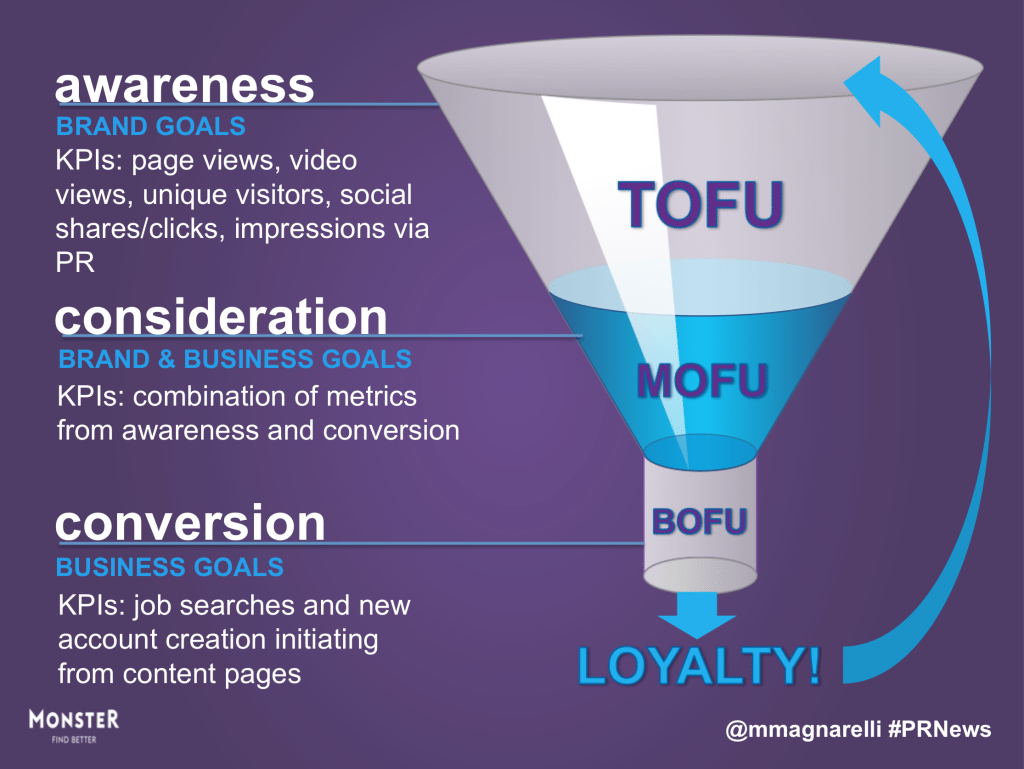
It's not news that social media has made everyone a publisher. Many brands are running quasi-newsrooms. We profiled a few years ago the newsroom-like set-up at Monster. Its then-chief, Margaret Magnarelli, offered best practices concerning publishing messages and raising awareness via a branded content newsroom. She's now executive director, growth marketing, Morgan Stanley.
Value Creation

Morgan Stanley
The main goal of the branded content area at Monster, titled Career Advice, is “to create value” for job seekers who visit, said Margaret Magnarelli, who was managing editor, content, at Monster. In addition, she said, value-laden content “is a differentiator” for the Monster.com site and positions “us as subject-matter experts…we have something to say, not just something to sell…we want people to come [to Monster] for the content and stay for the jobs.”
It’s critical, she said, that Monster is “very clear and transparent” about being a branded content site. For example, a link to airline jobs on Monster follows a recent story about an expected surge in hiring in the airline industry. A profile of companies with excellent paternity leave policies contains multiple links to Monster’s job listings for those companies.
Goals
The brand’s goals for the site's content—some 10 to 15 stories weekly, plus videos and podcasts—are to raise awareness of Monster and measure results.

A former journalist, Magnarelli segments the content her editorial staff (3 editors, 2 writers and a video producer) produces into: TOFU, MOFU and BOFU [see chart]. TOFU, or top of the funnel stories, contains general items, such as How to Handle a Toxic Boss and Why You Should Smile More at Work. TOFU contains thought-leadership articles and “doesn’t actively mention Monster.” MOFU, middle of the funnel stories, mentions Monster jobs/services “in passing” and contains calls to action (CTA), such as “join Monster” or “upload your resume.” BOFU content targets “very active job seekers…and tells them how to use Monster to find a job [and does not] shy away from CTAs.” Monster content is 80% journalism and 20% marketing, she said.
Segmented Content
She goes even further to segment content and her team into: WOW (articles that drive social engagement, about 20% of the site’s content), HOW (evergreen content such as educational and how-to articles, 10 Things You Can Do to Improve Your Career in 10 Minutes, 50% of the site) and NOW (breaking news stories, 30% of the site). A NOW story last week was a report on a survey that found 58% of health care IT leaders saying they expect to raise spending for project work, which should mean more jobs and higher wages for IT workers seeking jobs. the Monster 100 is another NOW example. Monster creates the monthly 100 using data about its site. The feature reports on the top 100 employers for that month at Monster. Magnarelli urged content creators to “befriend” data gatherers at their brand.
NOW stories, she said, begin with a news peg (something that happened that’s being reported in the media). The team then decides whether or not it can connect the story to Monster’s goals of getting people to seek jobs at its site. If it can, a team member looks for unique analysis.
PR-First Strategy: Pitch and Be Pitched
Magnarelli and her staff consider themselves media members, so they field story pitches from PR pros. They also hold a morning editorial meeting daily, set up news alerts on social, have specific beats, keep a roster of go-to experts and employ freelancers and columnists. Yet Monster’s content team also will pitch select stories to media outlets to raise awareness. For example, Monster used a “PR-first strategy” with a recent story it did about the trend of U.S. citizens seeking employment in Canada. The story was pitched to media outlets. It received 52 media hits, 668 million impressions and 10K page views.
A Sense of Humor
The site also has a sense of humor. An example is its treatment of a breaking story about the singer Kanye West, who tweeted last February about his personal debt of $53 million. The Monster team reacted with a tongue-in-cheek story about how many jobs West would need to escape from impecuniousness. Playing off last year’s Batman vs. Superman film, Monster created an infographic comparing the qualities the two superheroes bring to an employer. This last example also illustrates how branded content can be timely, she says, noting her team keeps an editorial calendar that lists upcoming events (such as film releases) and holidays, allowing writers to plan ahead to create content in response to events.
Magnarelli believes even small shops can publish branded content. Two stories published each week can be enough to “build an expectation” among followers…you don’t need [to publish] a lot of content” to be an effective branded content newsroom, pointing to the work of Cleveland Clinic.
NOTE: This content appeared originally in PR News, February, 27, 2017. For subscription information, please visit: https://www.prnewsonline.com/subscribe-now/
CONTACT: @mmagnarelli
